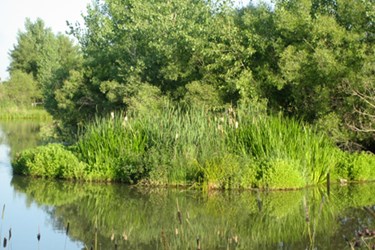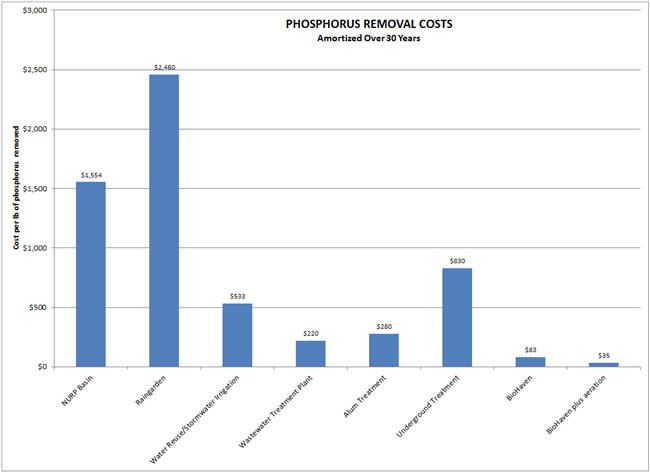Floating Islands For Stormwater And Other Applications

By Mark Reinsel, Apex Engineering

Floating islands, also known as floating treatment wetlands (FTWs), are a relatively new technology for improving water quality and creating habitat. Over 5,000 floating islands have been installed around the world in the past decade. Island sizes range from small decorative units to larger than football fields, and can be made in any shape or buoyancy. Islands have withstood numerous freeze/thaw cycles, as well as typhoons, tornadoes, hurricanes and major snowfalls.
Primary uses for FTWs include water quality improvement for stormwater, lake water and wastewater; fishery enhancement; destratification and dissolved oxygen addition; and creation of waterfowl and riparian edge wildlife habitat. The typical duty of FTW technology is to rapidly cycle nutrients into appropriate biota within target waterways. Secondary uses for FTWs include erosion control, wave dampening and structural platforms, stemming from the product’s materials and construction design. Removal rates have been developed in field-scale applications for contaminants such as ammonia, nitrate, phosphorus, metals, total suspended solids (TSS) and biochemical oxygen demand (BOD).
FTW demonstration projects have been completed by Floating Island International (FII) in collaboration with the USACE, USGS, NRCS, U.S. Forest Service, Government of Singapore, New Zealand’s National Institute of Water and Atmospheric Research, and others. FII’s team and collaborators includes biofilm and wetland researchers in North America and internationally.
Case Studies
Numerous case studies have been developed for stormwater, municipal wastewater, lakes and agricultural runoff, “living shorelines” and erosion control. Applications for landfill leachate and metals removal have also been explored. These studies show that a BioHaven® (the original FTW developed in 2004 by FII) will remove contaminants such as nitrogen, phosphorus, BOD, TSS, and total and dissolved metals.
- A BioHaven installed in the City of Billings (MT) Metra Park stormwater pond has effectively removed nutrients, metals and other contaminants, with average removal percentages ranging from 41% to 80% (Table 1). In November 2008, City of Billings personnel constructed a pond to treat a portion of stormwater discharges originating from a 174-acre drainage dominated by light industrial and commercial properties. A large BioHaven was installed in the Metra pond shortly after its construction, along with a smaller BioHaven in the channel preceding the pond. The FTWs were planted with native grasses and other vegetation in May 2009.

- Metra pond results agree with a detailed scientific study recently performed with FTWs in New Zealand. In that study, a stormwater pond with an FTW significantly outperformed a pond without an FTW, with removal of TSS, particulate zinc and particulate copper improved by 41%, 40% and 39%, respectively. It was theorized that biofilm attached to the plant roots provides a significant removal pathway for TSS and particulate metals. Due to changes in pH and dissolved oxygen induced by the FTW, adsorption and precipitation of dissolved metals also increased.
- At the Mermaid Pool waterway in New Jersey, FTWs removed an estimated 66 pounds of total phosphorus (TP) in one growing season, and were most effective when concentrations were greater than 0.1 mg/L. Average inlet and outlet TP concentrations were 0.105 and 0.065 mg/L, respectively, for a 38 percent reduction during the 2011 growing season. Prior to FTW installation, TP reduction in Mermaid Pool was 29 percent from standard settling and assimilation activities. Therefore, BioHavens reduced the TP concentration by about 9 percent with a net removal rate of 0.052 lb/yr of TP for each cubic foot of FTW.
- Landfill leachate is a problematic water stream to treat but initial results indicate that BioHavens can effectively improve its quality. BioHavens were installed to cover about 20% of the surface area of an existing lagoon system in New Zealand. Removal of color (see image below) and TSS (89% compared to pre-BioHaven samples) were exceptional, and FTWs also substantially removed total nitrogen and BOD.

FTWs can serve as an economically viable retrofit to stormwater ponds because they:
- Do not require earth moving;
- Eliminate the need for additional land to be dedicated to treatment;
- Will not reduce the pond storage volume because they float; and
- Adjust to fluctuating water levels.
FTWs for Nutrient Removal
Nutrients in water are problematic in North America and around the world. Under current best management practices, nitrogen and phosphorus tend to cycle into algae, cyanobacteria, aquatic plants or benthic organic matter poised to return to the waterway given appropriate conditions. Most waterways in the U.S. also experience at least occasional hypoxic (low oxygen) conditions. An estimated 25% of lakes in the U.S. experience even worse dissolved oxygen conditions and become anoxic seasonally. This factor greatly limits these waterways, preventing them from sustaining the biota that could otherwise continue cycling nutrients out of water.
Nature's wetland effect provides an alternative. Given sufficient biofilm reactive surface area in combination with circulation, biofilm-generating bacteria can cycle nutrients into periphyton at levels sufficient to keep up with both inflow and inventoried nutrients. Periphyton is the viable microfloral community attached to the surfaces of submerged objects in water; it comprises biofilm, algae, fungi, zooplankton and larger invertebrates.
Harvesting fish and other aquatic life fed by FTWs can be part of this strategy. By harvesting fish at levels that exceed influent nutrient quantities, waterways can be transitioned from a eutrophic or hypereutrophic level to mesotrophic, with corresponding improvement in all standard water quality parameters. When combined with strategic fishery management, biofilm/periphyton can provide a food base for up to 55 pounds of fish per acre-foot of water, based on a year-long study at Fish Fry Lake near Shepherd, MT. This mass of fish translates to removal of about 0.5 pounds of phosphorus per acre-foot. If left unattended, that same amount of phosphorus could cycle into about 3,600 pounds per year of aquatic plants or 550 pounds of filamentous algae.
In addition to removing phosphorus via the food web, FTWs can remove it via three other pathways:
- Incorporation into biomass in the FTWs. This mass will grow indefinitely and could be harvested periodically if not incorporated into the food web.
- Incorporation into biomass that will sink to the pond sediments, along with adsorption to sediment. This is one manner in which phosphorus is already sequestered in many ponds; FTWs can enhance this process and make it permanent by maintaining aerobic conditions, if aeration is included. Once phosphorus has been incorporated into biomass and sediment, it should remain precipitated and out of the waterway. Studies conducted at Michigan’s Houghton Lake over the past 40 years demonstrated that phosphorus will continue to accumulate within wetland soils. In that large wetland, the phosphorus concentration in treated municipal wastewater is reduced from about 3 mg/L to less than 0.1 mg/L.
- Phosphorus removal via plant uptake. Studies have shown that plant uptake of phosphorus comprises only 6% or less of the total removal. Most of this removal is contained in plant roots rather than above-surface vegetation.
Using public information, FII has developed a cost chart comparing BioHavens to other technologies for phosphorus removal (see chart below). BioHavens, either with or without aeration, have substantially lower costs than alternative technologies such as alum treatment.

FTWs are scalable by building larger units or multiple units. Islands for water treatment of very large water bodies and high nutrient loads, encompassing many acres, have been proposed and are being considered compared to more invasive, costly technologies such as dredging.
Summary
By biomimicking nature, FTWs provide the “concentrated wetland effect” that transitions nutrients through the food web. FTWs and natural floating islands are essentially simple biofilm reactors that can include plants.
FTWs have been used to treat a diverse selection of waters (stormwater, eutrophied lake water, raw municipal wastewater, treated wastewater, landfill leachate) with a wide variety of contaminants (suspended solids, nutrients, organics, metals). Numerous case studies provide removal rate estimates for these contaminants.
For more information, contact Mark Reinsel at apexengineering.us or see www.floatingislandinternational.com.
